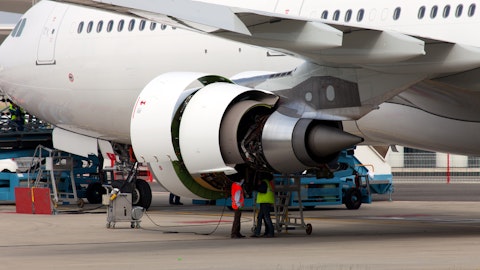Ron Dutt: Our heavy-duty models that we have planned to roll out all have UL certification achieved. And the material handling sector is one, our customers almost always want that UL listing. It’s the top-tier customers. They know it’s there and they want it. In this platform we’ve been rolling out though we do have ground support equipment that customers who don’t require the UL listing, so we have sent some of those 80-volt packs out to them. But what we are working on right now is getting the top-tier OEMs to approve these new packs in their trucks. And the scenario has shifted over the past few years from them doing the approval themselves, which can be a fairly quick turnaround to having third parties do that, which is a longer turnaround.
And so that’s why the rollout of our sales of our heavy-duty models have taken a little bit longer than expected. We have a project in now with our largest OEM partner, and it will be forthcoming through approval in the coming several months. So our salespeople are certainly eager for these packs to be able to sell because for some time we’ve seen – we’ve learned and come across much more – many more applications where the heavy-duty pack is just the right answer. It does matter whether we offer the 24, 36, 48 and 80 volts, it does matter whether you’re moving potato chips or engine blocks as well. So we want to cater to that entire line.
Sameer Joshi: Understood. Thanks for that color. On the integrated telematics, I know you said you will launch it later again in this – later in calendar 2024. Do we know what kind of revenues or cash flows we can expect from that? And do you expect several of your customers to adopt it or just a few?
Ron Dutt: Well, the telematics, we’ve offered telematics for several years, and it’s – I would characterize it as a first generation, it’s really borne out of our engineers, having a tool to assess the state of health, troubleshoot our models. And we start selling that to selected customers about over the past year or 2. And what we found is that many of the operations in both material handling and GSE had operated for many, many years without telematics on their battery and just didn’t think – they didn’t understand the real benefit of it for asset management, state of health, managing their packs, and what they found as they pilot and try these, they are very, very excited. So we’re – I think we’re going to see a continuing more rapid growth and rollout of this.
Now, we charge an amount to install the telematics, and we are also recently beginning to charge a monthly fee to provide services to support those people with customized reports and our other support services. So, we have got the initial fixed fee and the monthly fee. And we see that evolving to the point of being a huge leverage point to offer new features and capability for these – for our customers to manage their fleets. They have locations all over the country. They have lots of forklifts, lots of battery packs, of course, with that, and managing the life, forklifts do different jobs with telemetry. They can swap the batteries to extend the life. Everyone is into extending asset life because that’s dollars and cents. The other thing, and probably the more important there into is reducing downtime.
So, with telemetry, which is channeled through the cloud to the customers and us, we can provide downloads and repair packs, alert local techs to do repair work where a hands-on approach is needed, all of which can reduce the amount of downtime, which is critical for these high-performance operations. And what we are seeing is we have introduced these into the plants, and it has been very, very well-received. Lastly, I would say, look, this is software, and it’s kind of like our iPhones. I don’t know about you, but I get downloads all the time, improving this and new versions and iPhone 14, 15 and so forth. And that’s the path I see for this telemetry. And we are very, very excited about it because it’s a source not only of some income, but I think it’s even larger than that.
It’s a source of new business and a differentiation for our company. We are a first mover in this. There are others doing it. But it represents a source for us to get new business. It’s also beneficial for pricing. Now, simply put, it’s value creation, the value we see that the customer wants, not something that our engineers think is slick and clever, it’s what the customers want. So, it’s very exciting.
Sameer Joshi: Yes. No. Certainly, it is a high gross margin revenue stream as well. So, yes, we are looking forward to progress on that. My last question is just – I know you mentioned the $150 million capacity. But in terms of – on the operating side, with current operating expense levels, how much revenue can be supported or should we see some scaling of sales expenses as revenues increase?
Ron Dutt: Well, if I understand the question right, our capacity at this site is to be able to increase our production line to ship out of here $150 million of lithium battery packs per year. And the operating infrastructure is set to do that. We are not capital-intensive. As we double the size of that revenue, we expect a modest amount of additional tools and some testing equipment, a few more people. But we are very confident of that rollout. And particularly because we have two great enablers, we have ISO 9000 processes embedded here for the last 4 years, and we are very close to wrapping up lean manufacturing with this to make this efficient from the standpoint of expenses to support it, given the low capital expense that’s required for that, our expertise in that we can – we believe we have good line of sight on that. And sowing out a second shift, I mean a real functional second shift as well, all give us a lot of positive understanding of it.




